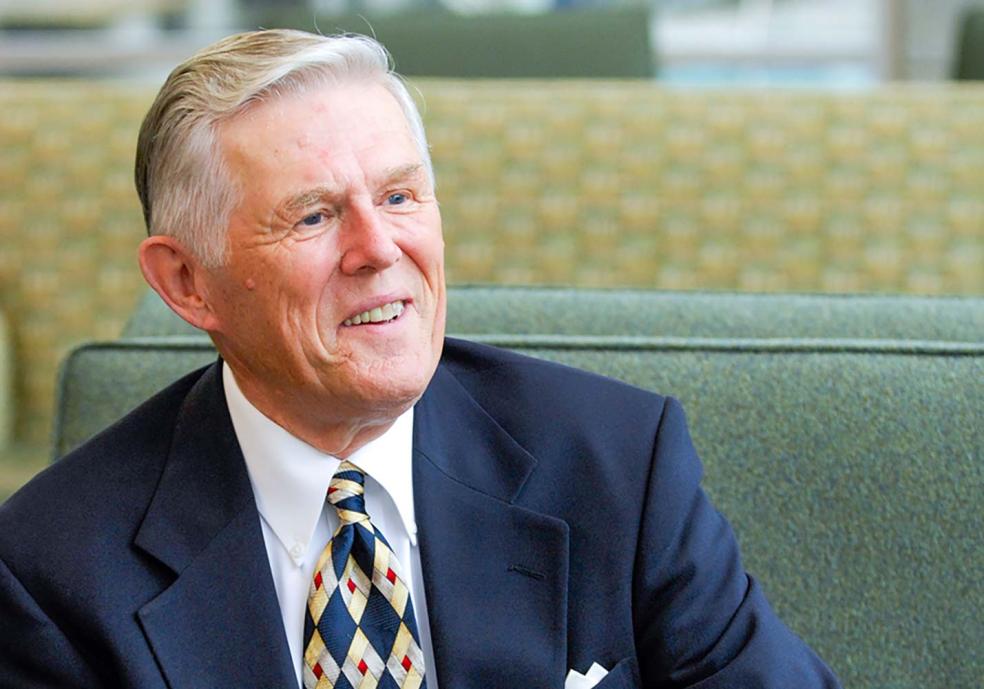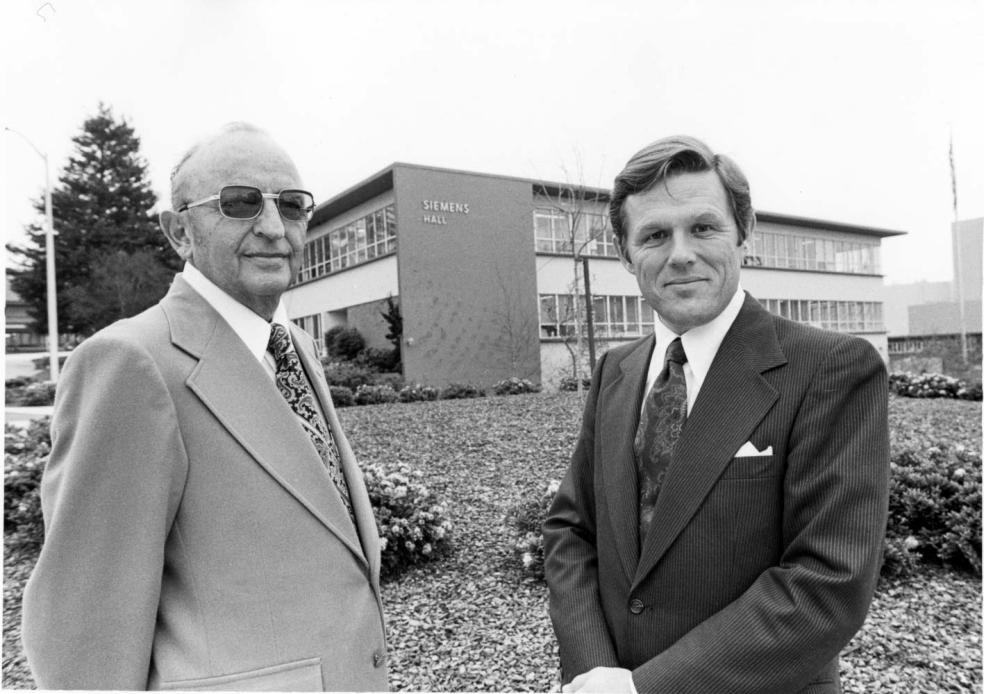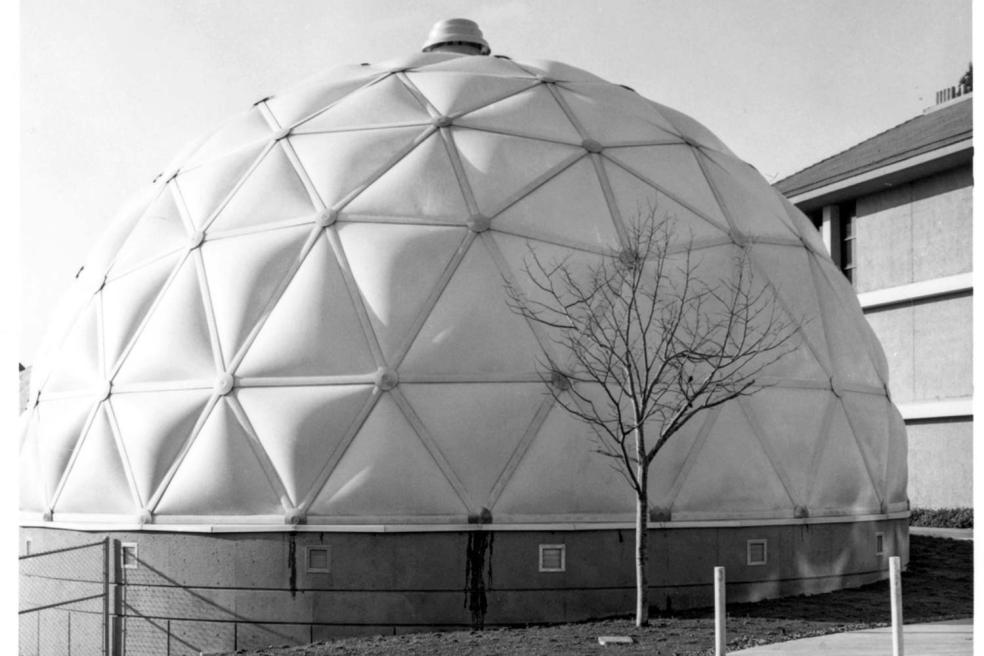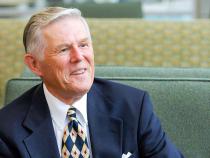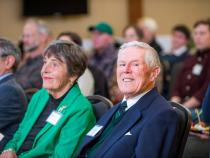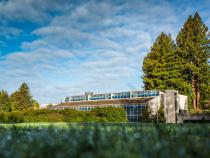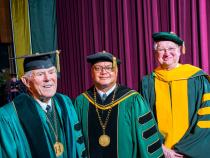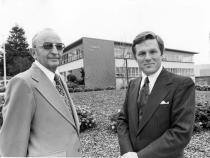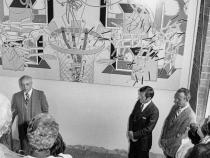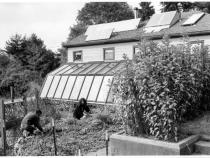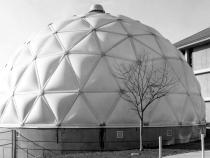He leaves behind his wife, Judith Saari McCrone, of 65 years; two sons Bruce and Craig; granddaughters Sarah Chelsea and Caitlyn; grandson Casey; great grandson Bowie, and his sister Kathleen McCrone who resides in Windsor, Ontario, Canada. He was preceded in death by his daughter Mary Ellen McCrone and his parents Hugh Macmillan McCrone and Kathleen Forth McCrone.
Dr. McCrone leaves a lasting impact on the University and the North Coast.
He became President of Humboldt State University in 1974 and served until 2002. His focus on academic quality was evident, as was his commitment to strengthening connections between the University and the broader community. He was particularly known for walking the campus to engage with students and faculty, an aspect of his role that he relished.
“Dr. McCrone had an amazing influence on the growth and development of this institution. We see his impact all around us, in the evolution of our academic programs, our facilities, and just who and what we have become today,” says Cal Poly Humboldt President Tom Jackson, Jr. “I am so thankful we had time, although brief, to listen to him about his views on Humboldt. He was a soft-spoken and humble man, but he couldn’t hide his pride in this University and in the role he was able to play here. We are so much better as a campus and as a society because of him. He set a standard for what it means to be a great human."
Dr. McCrone was born on Oct. 7, 1931, in Saskatchewan, Canada. He did geologic field work in Canada during the summers while he was completing a bachelor’s degree at the University of Saskatchewan, a master’s degree at the University of Nebraska, and his doctorate at the University of Kansas—graduating in 1961. His geological experience included research on sediments, geochemistry, biofacies, and pollution in the Hudson River Estuary and Long Island Sound in New York between 1959-1958. McCrone was a Field Party Chief in the Yukon and Northwest Territories of Canada in 1956-1958, and a field geologist in Alberta and British Columbia in 1954-1955, for the Shell Oil Company. Earlier, he did wellsite planning and geological supervision for private consultants and the British American Oil Company.
Dr. McCrone taught and served in administrative roles for 11 years at New York University, and served four years as the Academic Vice President at the University of the Pacific. From 1969-1970, he presented 48 half-hour lectures on geology for the CBS National Network "Sunrise Semester" program.
In keeping with his passion and enthusiasm for teaching, and to remain connected with the students, he also taught several Geology classes while he was president. “It is like a tonic for me to get back into the classroom,” he said in a 1980 interview. “By teaching every year I am able to share in the experiences of my faculty colleagues and consequently serve the academic enterprise with a better sense of current reality than is possible just from an administrative office.”
During his presidency, Dr. McCrone guided the University through enrollment declines and budget constraints, oversaw the expansion of academic programs and cultural resources, led the construction of many now-familiar buildings and facilities and worked to improve community-university relations. He became known for this commitment to academic excellence, and urged the faculty to work toward quality education.
Dr. McCrone began his presidency announcing his philosophy about the arts and humanities, according to A View From the Hill: A History of Humboldt State University. “The liberal arts are the very center of our culture," he said, announcing his intention to create at Humboldt an educational experience equivalent to that of a small liberal arts college.
He was focused on University academics, and in an interview described the meetings, discussions, and reviews of instruction that he was regularly involved in. Dr. McCrone also highlighted his vision of an ideal general education program as one that included: philosophy, English, science, and mathematics, history of ideas, political economy, foreign language, computer science, basic legal and business practices, world history, creative arts, industrial technologies, and natural resources.
“I believe that the academic fare of other departments should flow very freely and naturally from the substance of the general education program,” he said. “General education should not be viewed as a separate educational activity. It should be regarded as a fundamental part of the learning continuum that is the essence of the University.”
Soon after his inauguration in the mid 1970s, the natural resources fields showed renewed vigor, which was reflected in the job market and society’s growing environmental sensitivity. As a result, a new master’s degree emphasizing ecology and environment was introduced, and Humboldt dropped civil engineering in favor of environmental engineering.
Curricular changes also included a revised general education. Additionally, the University added ethnic studies, women’s studies, computer information systems, and Native American emphasis programs, as well as a handicapped learning credential, a graduate multicultural education degree, and a liberal studies degree in child development.
Dr. McCrone left a mark on seemingly every corner of campus. His presidency saw the development of numerous facilities, including the Telonicher Marine Lab, the Campus Center for Appropriate Technology, Science D (which has since been renamed in his honor), Science E, Student Business Services, Creekview Apartments, Schatz Energy Research Station, and the Marine Wildlife Care Center. A number of buildings were remodeled, expanded, or completed including Founders Hall, the Student Health Center, Gist Hall, the Library, the U.S. Department of Agriculture Redwood Sciences Laboratory of the Pacific Southwest Forest and Range Experiment Station, and the University’s Natural History Museum. Later, Geology occupied a remodeled lower level of Van Matre Hall and the Wildlife program received a new aviary.
Among the many achievements during Dr. McCrone’s presidency was the expansion of art and community service programs. In 1976, CenterArts began offering lectures and the arts to "bridge" campus and community interests. The campus also helped Arcata establish what would become the Arcata Marsh and Wildlife Sanctuary, a model for environmentally responsible waste disposal.
During his tenure, Youth Educational Services reached out to the Humboldt County jail and assisted teenage mothers through a family issues program. A new Adult Re-entry Center helped older students make the transition to college life.
Native American Career Education in Natural Resources—now called INRSEP (Indian Natural
Resource, Science & Engineering Program)—was established in 1974. INRSEP + Diversity in STEM supports historically underrepresented students in the sciences.
Research was an important aspect of Dr. McCrone’s work. To build local morale and promote faculty research, he established the University’s Institute for Research and Creative Projects in 1980. The Scholar of the Year award came into being in 1986.
Upon Dr. McCrone’s retirement, the California State University recognized his role as helping “shape the university into what is widely recognized as a unique educational experience for tens of thousands of students.”
Dr. McCrone’s sense of community has had a lasting impact on the North Coast. By the time of his retirement in 2002, the University was known as “one of the largest per capita sources of Peace Corps volunteers, while some 4,000 of its 7,500 students volunteer for community service every year,” the CSU noted.
In addition to his service as president, Dr. McCrone and his wife, Judith, have continued to stay involved with Cal Poly Humboldt and the community over the years, including supporting the work of graduate students, promising faculty, and academic departments.
The McCrones have been long-time supporters of various areas throughout the University—including the Geology department, the Library, Youth Educational Services, and others. They helped establish the McCrone Promising Faculty Scholars Award and the Alistair and Judith McCrone Graduate Fellowship, which have benefited more than 50 faculty members and 20 graduate students.
In 2021, the University honored Dr. McCrone by renaming the Science D Building as Alistair McCrone Hall.
An intimate family gathering will be held in Washington to celebrate his life and achievements.
